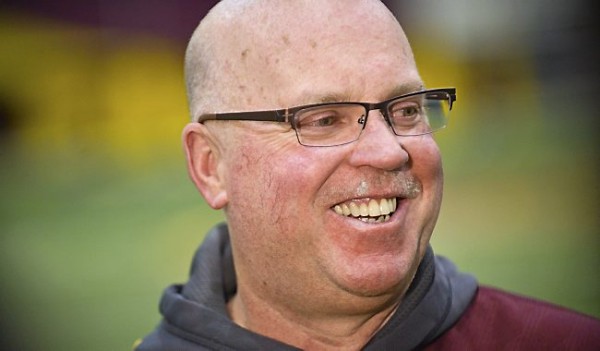The Minnesota Golden Gophers have endured a difficult 2015 season, and that journey became a lot more painful on Wednesday morning.
Head coach Jerry Kill had to retire from coaching due to the health problems he has faced for years. Kill becomes the third coach to retire from coaching during this season, joining Steve Spurrier (South Carolina) and George O’Leary (UCF).
Kill leaves behind a rich legacy, having built Northern Illinois to the point that the Huskies could make the Orange Bowl under successor Dave Doeren in the 2012 season. He then improved Minnesota to a considerable degree, leading the program to the Citrus Bowl last season, its most prestigious postseason destination since the 1962 Rose Bowl against UCLA.
Let’s say a little more about that 1962 Rose Bowl game: It marked the end of the Golden Gophers’ third great era in their history, under head coach Murray Warmath. The first was created by Henry Williams in pre-World War I times. (Williams Arena, the school’s basketball gymnasium? Yeah — that’s Henry Williams.) The second — and greatest — era came under Bernie Bierman in the 1930s, when the program won multiple national championships. (For perspective, this was when the Associated Press Poll began to be used on an annual basis in college football — 1936, to be specific.)
Jerry Kill never reached those heights, but he established himself as one of the better coaches in Minnesota football history. His departure from the scene creates two fundamental stories: a story of pain, and a story in which the program must find a way forward.
*
First, the pain of this moment is considerable enough in isolation. It’s even more wrenching given the context in which Jerry Kill retired from coaching.
Kill’s retirement comes three days after the death of Minnesota basketball icon Flip Saunders. A player for the Golden Gophers and the head coach and president of the NBA Timberwolves, Saunders was — alongside Kevin Garnett — the most public face for the sport of basketball in Minnesota. Passing away at age 60 represents an early death, depriving a team and a statewide community of a cherished presence.
Jerry Kill — plagued by seizures during gamedays in recent years — is thankfully able to step away from coaching at a point in time when his long-term health can be preserved. This is a blessing, and so the event is nowhere near as traumatic as Saunders’s death. Yet, it is still a loss for a state and a school that remain heartbroken over Flip Saunders, gone far too soon in Minneapolis. Pain added to pain is a profound and central part of Wednesday morning’s news at the University of Minnesota.
*
While the school tries to absorb the sadness of this day, it must think about its next move. While it’s natural — and quite reasonable — to consider outside candidates, especially the next young hotshot coach who will ripen into a star, this seems to be a coaching situation in which a staffer should get a promotion to a permanent position.
The question is: “For how long?”
Interim coach Tracy Claeys has been the defensive coordinator for the Golden Gophers under Kill. He ran the team when Kill could not, due to his health problems. Claeys showed against Nebraska and other formidable Big Ten West programs that he could scheme and plan in ways which put his players in position to succeed. He has demonstrated considerable competence. Instructively, he has shown he can implement Kill’s methods as the leader of this team in a gameday setting. He makes a lot of sense as the new replacement for Kill. His reputation, experience in handling difficult situations, and familiarity with the program itself all point to retention as the team’s next permanent coach.
That doesn’t seem to be a hard call right now.
What IS the hard call: How much time to give Claeys as the permanent coach?
There’s something to be said for giving Claeys two seasons, no matter what. If a coach is going to get a fair chance to do something after an unexpected event puts him in a position of authority, the cushion of a second season tells that coach he can learn a little bit on the job. A two-year run would be fair to Claeys and the players. One could not find much fault with that decision if the school thinks it’s appropriate.
The other fundamental option would be to give Claeys the 2016 season without any long(er)-term assurances that he’ll have 2017. What’s worth saying here is that since Kill has retired midway through the season, Claeys has a little more of a head start on 2016 than if Kill had retired at the end of the regular season. This makes Claeys the leader of the program for the next month with some sense of how to proceed. This extra amount of time means that if 2016 goes south (really south), Minnesota can say with a considerable degree of legitimacy, “Tracy, we appreciate all you’ve done, and we gave it a whirl this year, but we do need to look for an established head coach.”
There’s a lot to consider for the University of Minnesota football program right now. As the school and the state absorb yet more pain in the world of sports, a lot of thought and care must inform the way the Gophers handle Tracy Claeys and their larger football operations.
